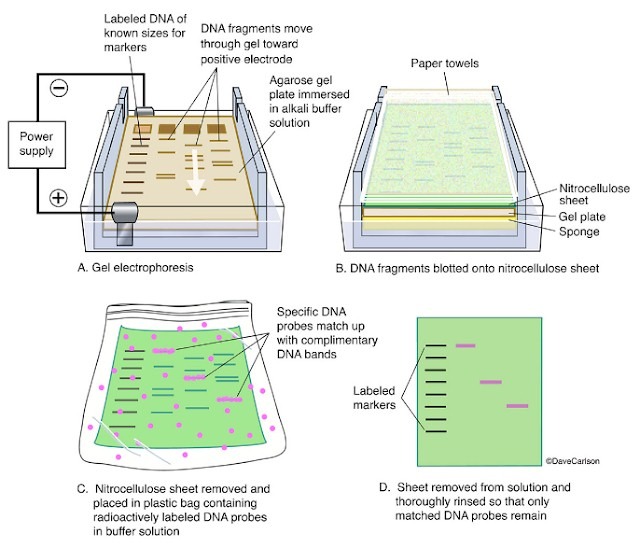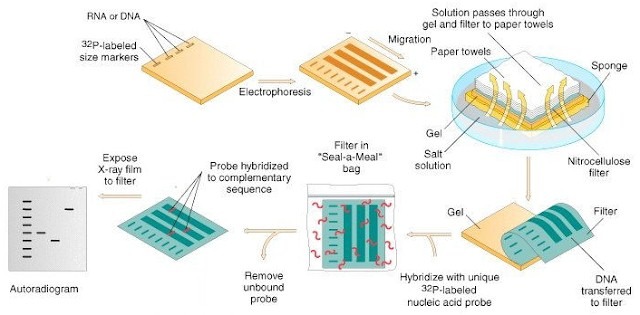Southern Blotting
Another problem early biotechnologists faced was the inability to distinguish the fragment of DNA possessing the gene of interest from the numerous chromosomal fragments produced by restriction enzyme digestion of an organism’s genome.
In 1975 Edwin Southern solved this problem with his Southern blotting technique.
This procedure enables the detection of specific DNA fragments from a mixture of DNA molecules.
Southern blotting is a three-step process: separate DNA molecules by electrophoresis, transfer separated DNA molecules to a membrane, and hybridize to a labeled probe specific for the gene of interest.

After the DNA fragments are separated by agarose gel electrophoresis, they are rendered single stranded (i.e., denatured). The denatured DNA molecules are next transferred and bound to a nylon membrane.
The DNA of interest is identified by bathing the filter in a solution that contain a radioactive probe, which is a fragment of labeled, single-stranded nucleic acid complementary to the DNA of interest.
The DNA to which the probe hydrogen bonds is now radioactive and is readily detected by autoradiography.
In autoradiography, a sheet of photographic film is placed over the membrane. When the film is developed, bands appear wherever the radioactive probe is bound because the energy released by the isotope causes the formation of dark silver grains. Nonradioactive probes may also be used to detect specific DNAs.

A common label is the small molecule biotin, Non radioactive labels often are more rapidly detected and are safer to use than radioisotopes.
By the late 1970s the techniques for cloning DNA were harnessed to produce recombinant human insulin, and by 1982 commercial production of insulin from genetically engineered E. coli began.
This was an important development for several reasons: first, diabetic individuals no longer had to depend on insulin from pigs or other animals; second, it demonstrated the commercial feasibility of using recombinant DNA to make a better product.
Reference and Sources
- 1% – https://quizlet.com/218117184/success-in-cls-ch-10-molecular-diagnostics-flash-cards/
- 2% – https://en.m.wikipedia.org/wiki/Western_blot
- 1% – https://www.sciencedirect.com/science/article/pii/S1350946218300715
Also Read
- Endospore staining and capsule staining of the bacteria
- Electrophoresis: Overview, Principles and Types
- Gel electrophoresis: types, principles, instrumentation and applications
- Omicron: Overview, Transmissible, Vaccination and Severity of disease
- Molecular Detection of Microorganisms: Intro, Molecular methods, Applications

